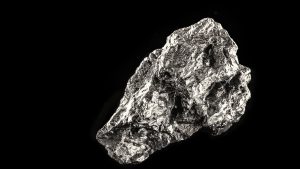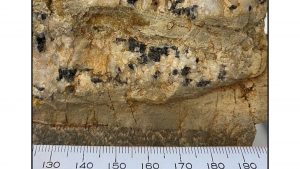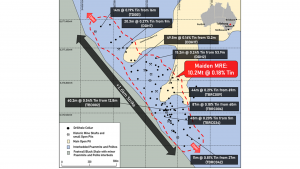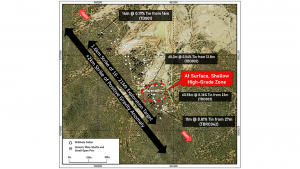Tin is a valuable and steadfast component in a range of applications. Sky Metals tells us how the company is answering the demands of the renewable energy market through its Tallebung Tin Project.
Sky Metals Limited (ASX: SKY) is an ASX-listed public company focused on developing and exploring mineral resources in Australia. The company’s project portfolio offers important exposure to the tin market.
Tin is a vital component in the manufacturing of new, renewable energy applications and is used predominantly for soldering. As such, prices and demand for this versatile metal are increasing, leading to challenges in supply and the need to diversify sources from unstable regions.
The Tallebung tin field is situated in the eastern foothills of the Black Range, located in the central west of New South Wales, Australia. The project is wholly owned by SKY. It plans to develop this extensive resource into a new ethical source for tin and supply global electrification needs.
Tallebung is approximately 70km northwest of Condobolin, where SKY has a +16-21 Mt exploration target for over 30,000t of contained tin, and a +10 Mt maiden Mineral Resource Estimate (MRE).
This maiden MRE and Exploration Target demonstrate the large-scale tin system that SKY is exploring at Tallebung. Follow-up work will focus on expanding on initial estimates to continue to grow this significant target. SKY plans to drill to infill and, ultimately, upgrade and expand this maiden MRE and exploration target in the following months to continue developing the Tallebung Tin Project.
An ever-growing market
Despite underinvestment in tin exploration over the past 30 years, the market has recently seen rapid price growth due to soaring demand for modern applications integral to the green energy transition. According to the Rio Tinto Ventures Group, tin is set to be the ‘metal most impacted by future technologies.’
The majority of the tin supply currently comes from China and Indonesia. Australia currently supplies around 2-3%, only a tiny fraction of the global supply.
Ongoing supply disruptors across the tin market include declining Myanmar artisanal production, culminating in the recent announcement that Myanmar plans to ban all tin concentrate exports and Indonesian tin exports, with an impending export ban in 2024.
The Tallebung Tin Project
The tin field represents a site of significant tin and tungsten production from high-grade quartz lodes and their associated alluvial and deep lead deposits. In addition, the historic Tallebung tin mining field at the northern extent of the Wagga Tin Belt includes the site of mainland Australia’s most significant historic tin resource at Ardlethan (>31,500t of tin). It is considered prospective for lode and porphyry-style tin–tungsten mineralisation.
The Tallebung Group sediments in the Tallebung tin field area outcrop as a sequence of weakly metamorphosed shales, siltstones, carbonaceous mudstones, and minor quartz-rich sandstones. The rocks are tightly folded, striking NNW at around 330o with variable dips. Previous workers have subdivided the Tallebung group into five mappable units.
Maiden mineral resource estimate and exploration target – JORC-2012

An exploration target at the Tallebung Tin Project of approximately 16 – 21 Mt, at a grade ranging between 0.16 – 0.20% tin and a cut-off grade of 0.10% tin for over 30,000t of tin, has been defined from the drilling completed to date. As well as this, a maiden inferred JORC-2012 mineral resource estimate of 10.2 Mt 0.18% tin at a 0.10% tin cut-off grade. SKY is very encouraged by this maiden inferred MRE, which is only limited in size by the amount of drilling completed to date. SKY plans follow-up drilling programmes to expand this promising maiden MRE and grow this large-scale tin deposit.
Oliver Davies, CEO of Sky Metals Limited, commented: “This maiden MRE and exploration target demonstrate the large scale of the tin mineralisation at Tallebung. This, in combination with the more than tripling of grade achieved with the upfront TOMRA XRT ore sorting, shows what an excellent opportunity SKY is developing at Tallebung. SKY has also shown that tin mineralisation is very amenable to simple and cost-effective gravity concentration to a saleable +60% tin concentrate. It is exciting to consider that this resource and exploration target remain open along strike and down dip. This Maiden Mineral Resource Estimate is only limited by the drilling completed so far. SKY will aim to grow this resource even further with additional drilling over the coming months.”
TOMRA ore sorting can be applied to this ore and has shown that the grade can be at least tripled to over 0.5% tin, with over 98% recovery of tin. Estimates are open along strike and down dip showing strong potential for significant increases in this maiden resource estimate, with further drilling at Tallebung.
Mining history of the Tallebung tin mining field
The project is centred on the historic Tallebung tin field, where numerous phases of mining activity have occurred over more than 100 years since its discovery in the 1890s. This activity targeted the high-grade quartz lodes and the alluvial/colluvial material with an estimated historical production of 3,350 tonnes of tin concentrate. SKY is now targeting the bulk tonnage tin mineralisation underlying these historic mining areas.
Due to past mining activities at Tallebung, much of the costly infrastructure required for a mining operation is already in place. This includes powerlines, all-weather haul roads to and within the site and an established water supply. Combined, these will provide a solid start to future mining operations.
Sustainability
SKY aims to be an industry leader in ethical and sustainable mining practices. The Tallebung tin mineralisation is hosted in quartz-cassiterite veining within a predominately homogeneous sequence of less than 1m thick interbeds of sand and siltstones, which have formed into tight isoclinal folds. Within veining at Tallebung, the tin mineralisation occurs as cassiterite and is present as significant, often 5-10mm wide ‘nuggets’.

The saleable tin concentrate can easily be produced from the Tallebung ore, given the nuggety cassiterite host of the tin mineralisation. The coarse liberation size of the cassiterite means that it does not require large amounts of energy to crush and grind. TOMRA ore sorting technology and gravity concentration methods work exceptionally well to save significant amounts of power and water in the processing plant.
The TOMRA ore sorting process at Tallebung requires no water or chemicals and reduces the total mass for further processing by at least 60-70%. In addition, this technology significantly reduces water use by a similar 60-70% during processing. Additional work is planned to use the rejected 60-70% of the mass from the ore sorting as barren waste material for sheeting roads and other construction projects.
In addition to the ore sorting benefits, the gravity processing method to concentrate the tin at Tallebung only uses water recycled through the plant. This further reduces water requirements and avoids using large quantities of chemicals required by other tin concentration processing methods.
The uniquely simple and cost-effective processing in Tallebung makes it a likely leader in producing sustainable tin.

Next steps
This maiden MRE and exploration target demonstrate the large-scale tin system that SKY is exploring at Tallebung to provide tin for the growing international demand. Follow-up work will focus on expanding these initial estimates to continue to grow this significant tin deposit. SKY is planning drilling to infill and, ultimately, upgrade and expand this maiden MRE and exploration target in the following months to continue developing the Tallebung Tin Project.
Additionally, a gravity geophysical survey completed in 2019 showed that a positive gravity anomaly coincides with the tin at Tallebung and extends well beyond the current extent of drilling, indicating that the exploration target and inferred MRE remain open over more than 2km. This is significantly more than the recent 1.6km strike drilled to date, indicating that there is still lots of room to grow the extensive tin resource at Tallebung, and build a new ethical Australian resource that can supply tin for global electrification needs.

Please note, this article will also appear in the fourteenth edition of our quarterly publication.









